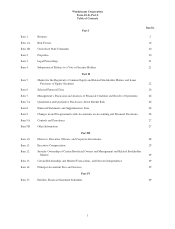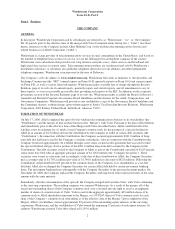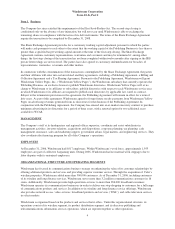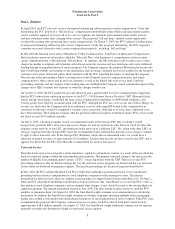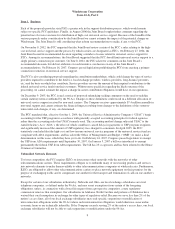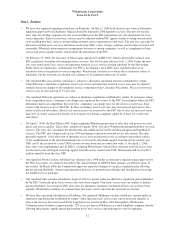Windstream 2006 Annual Report Download - page 71
Download and view the complete annual report
Please find page 71 of the 2006 Windstream annual report below. You can navigate through the pages in the report by either clicking on the pages listed below, or by using the keyword search tool below to find specific information within the annual report.
Windstream Corporation
Form 10-K, Part I
Item 1. Business
broadband service is a strategic imperative for Windstream. During 2006, Windstream added approximately 258,000
broadband customers, including 67,000 acquired with Valor, continuing a trend of strong growth in this service offering.
For the twelve months ended December 31, 2006, the number of broadband customers grew by 65 percent to
approximately 656,000 customers. Approximately 75-80 percent of our lines are broadband-capable. During 2006, the
growth rate in Windstream’s broadband customers outpaced the rate of decline in customer access lines discussed above.
Although broadband services have been a source of revenue and customer growth for Windstream, that service offering
experiences competition from other broadband service providers, including cable television and satellite transmission
service providers. Under the FCC recent decision in its Triennial Review proceeding, as further discussed below under
the caption “Regulation – Federal Regulation”, it appears that Windstream’s provisioning of broadband services will be
largely deregulated. In addition, a number of carriers have begun offering voice telecommunications services utilizing
the Internet as the means of transmitting those calls. This service, commonly know as VoIP telephony, is challenging
existing regulatory definitions. As further discussed below under the caption “Regulation – VoIP Telephony”, on
March 10, 2004, the FCC adopted a Notice of Proposed Rulemaking that will consider the appropriate regulatory
treatment of Internet-enabled communications services and address which regulatory requirements (for example, those
relating to E-911, disability accessibility, access charges, and universal service) should be extended to Internet-enabled
services. The results of the FCC’s proceedings related to VoIP could have a significant effect on Windstream’s
wireline operations.
REGULATION
Our incumbent local exchange carrier subsidiaries (our “ILECs”) are regulated by both federal and state agencies. Our
interstate products and services and the related earnings are subject to federal regulation by FCC and our local and
intrastate products and services and the related earnings are subject to regulation by state Public Service Commissions
(“PSCs”). The FCC has primary jurisdiction over interstate switched and special access rates and broadband service
offerings and regulates the rates that ILECs may charge for the use of their local networks in originating or terminating
interstate and international transmissions. State PSCs have primary jurisdiction over matters including local service rates,
intrastate access rates, quality of service, depreciation rates, the disposition of public utility property, the issuance of
securities or debt by the local operating companies, and the accounting systems used by telecommunication companies.
FEDERAL REGULATION
Today, communications services providers are regulated differently depending primarily upon the network technology
used to deliver the service. This patchwork regulatory approach unfairly advantages certain companies and
disadvantages others. It impedes market-based competition where service providers, regardless of technology,
exchange telecommunications traffic between their networks and compete for customers.
Windstream strongly supports the modernization of the nation’s telecommunications laws, but at this time, cannot
predict the timing and the resulting financial impact of any possible federal legislative efforts. In an effort to reform the
patchwork regulatory approach, a number of different reform bills were introduced – but not passed – during the last
session of Congress. In the early stages of the new Congress it is difficult to predict what kind of reform efforts, if any,
may be introduced and ultimately become law.
Inter-carrier Compensation
Our local exchange subsidiaries currently receive compensation from other telecommunications providers, including
long-distance companies, for origination and termination of inter-exchange traffic through network access charges or
toll settlements that are established in accordance with state and federal laws.
With the exception of the Nebraska, New Mexico and a portion of the Kentucky, Oklahoma and Texas operations, our
interstate ILEC operations, consisting primarily of network access charges, are subject to rate-of-return regulation by
the FCC. The Nebraska, New Mexico and a portion of the Kentucky, Oklahoma and Texas interstate operations are
subject to price-cap regulation by the FCC that allows more pricing flexibility than do our rate-of-return operations.
Companies meeting certain criteria had the option to elect price-cap regulation for interstate services as part of an FCC
order issued in May 2000 (the “CALLS plan”). The CALLS plan expired on June 30, 2005, and to date, the FCC had
not established a successor mechanism for regulating price-cap companies. Nonetheless, the rules put in place by
adoption of the CALLS plan remain in effect until the FCC modifies or otherwise replaces them.
7






